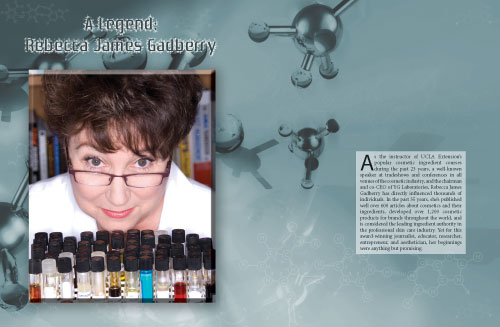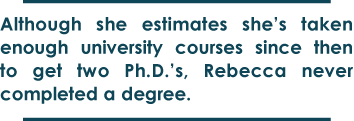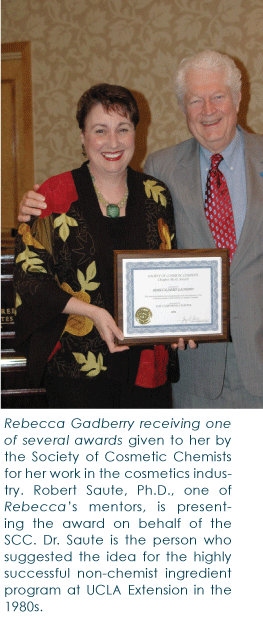
AN EARLY START
As the only child of a single parent, Rebecca started contributing to the family household at an early age. In 1964, Rebecca’s mother, Jean, realized her job wasn’t going to provide them with the lifestyle she envisioned after her second marriage ended in divorce. A small party planning company selling cosmetics from Dallas had just started looking for women in California to join their team. Seeing an opportunity to merge her background as a fashion model with her core belief that when people looked their best their self-confidence became stronger and their lives went better, Jean became one of the first Mary Kay women on the West Coast.

Within a few months, her business grew to need another hand. So Jean recruited her 10-year-old daughter, teaching her the company’s skin care methods and philosophy, how to do a facial, apply makeup, and how to sell. Sometimes the two were so busy they’d work Thursday and Friday nights as well as Saturday and Sunday. By 14, Rebecca was contributing half the rent and utilities, had her own phone and was putting a little money away for college. Then the tax man came calling. “I don’t know if she didn’t pay taxes on the extra income or whether she underpaid, but there was a time when we were flat broke yet still working hard,” remembers Rebecca. “We ate mayonnaise sandwiches seven days a week for a while. That Christmas, we wrapped empty boxes using old Christmas paper. Christmas morning, we opened our ‘presents’, saying aloud to one another what we wanted to be inside. You probably didn’t know you can fit an end to the Vietnam War inside a box, but we did. We both remembered it as our best Christmas until my son, Nik, was born.”
Graduating early from high school, Rebecca headed off to Occidental College – a small liberal arts school in Eagle Rock, Calif. – where she majored in anthropology, archaeology, and linguistics. “Now, I’d probably go into cell biology,” she confesses. “I guess it’s one of those ‘if I knew then what I know now’ moments; but on the other hand, if I’d gone into research, I may not have touched as many lives as I have. And for that, I’m thankful.”
LIFE AFTER COLLEGE
Not having enough money to finish her degree, Rebecca transferred to the university in her hometown of Long Beach, Calif. a year short of graduation. But her time there was cut short when her mother needed her to go on the road selling a new line of skin care to beauty salons across the country. Feeling like she didn’t know enough to discuss the topic with trained beauty professionals, Rebecca read every book in the local library and bookstore, and then began visiting libraries in the towns she visited for her mother’s company. “I used to train in the evening, which gave me plenty of time during the day to go to the local library and read whatever they had on hand,” she recalls.
Rebecca’s time on the road proved so successful Jean asked her to join the company full-time, so she left college to work in the factory and assist at the lab bench as well as train new accounts. Although she estimates she’s taken enough university courses since then to get two Ph.D.’s, Rebecca never completed a degree. Instead, she created her own curriculum, blending classroom study with books, the Internet, and interviewing leading authorities about the topics that interest her. Rebecca credits her pursuit of knowledge for leading to her writing career. “I had interests about which I wanted to know more, so I’d call an editor, propose the topic, then write the article. I thought of them as term papers, actually. I’d research, create a list of questions, learn who were the best experts to provide the answers, then call and interview them. Then I’d write it all up.”
Late in the 1970s, Rebecca heard about a new license California was about to offer, allowing established skin care professionals to take a two-part test to obtain their license. Rebecca received her aesthetician (then called a “cosmetician”) license on the first day the test was offered, along with Barbara Salomone, a close friend who founded the professional skin care brand Bioelements, several years later. By the early 1980s, Rebecca was advising the state in its aesthetics license curriculum.
About this time, Rebecca was also reviewed by the national board of the Society of Cosmetic Chemists for her work in skin care research and development. Although she didn’t have a science degree, she was one of two people that year which the board granted full membership rights. To this day, she serves on the board of directors of the SCC’s California Chapter, where she’s held various chairs in education. In 2003, she received awards from the California Chapter and National SCC for her paper, “The Ongoing Quest to Discover the Etiology of Rosacea with Implications for the Cosmetic Developer,” and in 2004 was awarded the society’s Chapter Merit Award for her extensive contributions in education and other work to support members of the cosmetic industry during the past 30 years.

LOOKING FOR INSPIRATION
Over the years, Rebecca has been inspired by an assortment of role models, starting with Leonardo da Vinci when she was eight. “I wasn’t fascinated by his painting skills. He was talented in so many areas, and he was a passionate expert about them all. Through Leonardo, I gave myself permission to have a wandering mind and to follow many passions.”
Today she pursues an array of seemingly unrelated interests, including continually updating her knowledge about skin biology, genetics, proteomics, and cosmetic chemistry, while exploring developments in branding, training and marketing techniques, building online communities, politics, designing and making jewelry, and contributing to the global community.
Many on the YG team share an avid interest in this last topic. “As we look at developing new programs at the company, we’re also asking what we can do to use our business to help others. Being in the same industry for over 40 years can lead to boredom,” she admits, “even with all the projects we handle and the variety of commitments I have in the industry. I’m actually enjoying business more now because we’re not just changing people’s lives with the skin care we make; we can also affect people’s ability to survive and improve the quality of their lives. This adds a whole new layer of gratitude and energy to my work.”
More than Leonardo, Rebecca’s most influential role model was her mother, Jean Dodd Haddad, who founded the predecessor company to YG Laboratories in 1974. A former fashion model and artist, Jean instilled in her daughter a love of learning and a strong dedication to others. “She used to tell me I had talent I had yet to discover, that I had a capacity to do whatever I put my mind to. She always saw me as a leader, even when I didn’t, and kept me mindful that I had a responsibility towards people to help them better themselves.” As a reminder, to this day Rebecca has a quote on her desk that reads, “I get what I want when I help others get what they want.”
Jean herself was a master of resiliency and perseverance. “She was one of the original self-made women,” remembers her daughter. In the early 1970s when Rebecca was in college, Jean developed a life-threatening disorder that landed her in a wheelchair for several months. Doctors gave her 10 years to live, advising her to avoid stressful situations and “take life easy”. “My mother’s answer was to buy the original company that became YG.” Jean later told Rebecca she wanted to leave a legacy to her daughter, which she didn’t realize until doctors defined how long she had left to live. “So Mother bought what she thought was a skin care factory with a cosmetic chemist, 20 formulas, and five large accounts.” What she actually bought was more like a garage with one filling machine and five small accounts that bought variations of five basic products. The chemist turned out to be an unlicensed pharmacist from Spain who once worked as a janitor for Helena Rubenstein. Never one to quit, Jean got in her wheelchair and flew to her five accounts to tell them she had bought the company and guaranteed good service and a quality product. Within a year, the company had more accounts and had more than doubled in size.
Although Jean passed away in 2000, Rebecca and her partner, Robert James, make sure her ethical principles of quality, fairness, honesty, and perseverance are maintained as core elements within the company. Jean left the two former marrieds equal shares of the company in her will. Robert, who has been with the company since 1977 and was vice president of production at the time of Jean’s passing, is YG’s co-CEO and CFO, overseeing all aspects of production as well as the company’s finances. Rebecca, YG’s chairperson and other CEO, heads up product development, marketing, education, and sales while continuing her writing and lecturing commitments and teaching three courses about the skin and skin care ingredients at UCLA each year.

Rebecca’s husband, Darnell Gadberry, governs the company’s administrative and legal responsibilities while using his broad background as a computer hardware and software engineer to create the company’s computer technologies and continually improve YG’s factory efficiencies. The three form YG’s Executive Team, which takes the place of a president in the corporate structure. Today, YG is six times larger than when Jean was alive, and is home to an enthusiastic, passionate, and creative group of professionals, including the Gadberry’s son Nik, who are dedicated to producing the best in high performance skin care and educational programs in the professional industry.
LOOKING TO THE FUTURE
What does the future hold for Rebecca and YG? “New products, new programs, new challenges. And always, always looking for more ways to help people improve their means and ability to believe in themselves and their futures.” She’s about to introduce a new group of products that are the culmination of over 15 years of biochemical research into how stress effects the body, especially the skin. “Being under constant stress myself, I’ve long been intrigued about how stress chemicals affect the body. Stress research has increased quite a bit since 9/11, allowing us to have a good idea of what triggers these chemicals. We’ve even been able to identify certain skin care ingredients to control the visible effects of stress. Since we’re all under stress these days. I’m just glad there’s something we can do about it.”
Two of the programs set to launch early this year are her new blog, My View From The Test Tube (rebeccajamesgadberry.com), as well as podcasts, one from her and one from Team YG (yglabs.com/podcasts).
She plans on discussing biochemistry and ingredient technologies in her blog and podcast, interviewing leading skin and ingredient researchers around the world. Team YG will share tips on how to care for clients’ skin, how to develop a brand, and how to educate and market to clients.
At 54, is Rebecca thinking about retiring from the world of aesthetics? Yes and no, she says. “I believe we all have our time, and eventually we must prepare the way for others to succeed us. So for years I’ve been mentoring others to replace me in their own ways. One of the best parts of my life is when I see one of my ‘mentees’ do something better than me, just like my mother did with me.
“It really brings home the message that we wouldn’t be here if it weren’t for the support of others. Knowing this, my life feels full. I feel like I’m a success.”